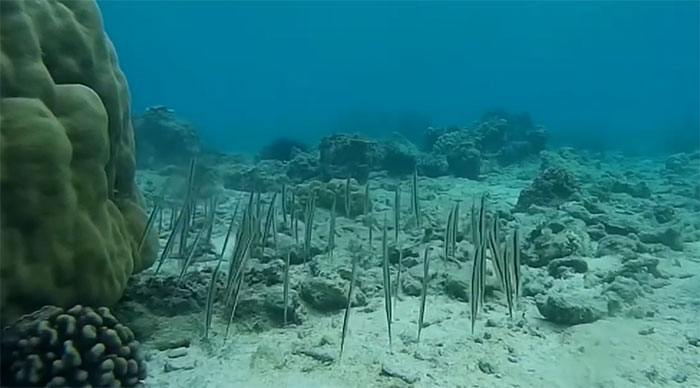Strange fish with vertical swimming posture
Razorfish possess a unique swimming style that allows them to both evade predators and ambush hiding prey.
(Video: Dumagat Freedive).
The razorfish ( Aeoliscus strigatus ) typically floats in the water with its body upright and its head facing down. This slender, elongated fish is often found among coral branches, seagrass beds, and sea urchin spines, according to IFL Science .
Vertical swimming allows razorfish to hide easily even when moving in large synchronized schools. Their body coloration also helps. Individuals living in different habitats wear different colors to camouflage themselves. For example, razorfish living in seagrass habitats often have a yellowish-green coloration on their backs. They conceal themselves by swimming in an unusual way that serves a dual purpose. This behavior not only helps them avoid large predatory fish, but also helps them ambush their prey when the opportunity arises.

How razor fish swim.
Razorfish prey typically consists of small invertebrates such as arthropods and copepods. These tiny crustaceans sometimes take refuge in the spines of sea urchins. Because of the razorfish's unique camouflage, they may not even notice an intruder. Their innovative swimming style is not the only notable feature of the razorfish. Their small bodies are covered in thin bony scales that form a transparent armor. Their fins are also unique in that the caudal fin is located on the belly , replacing the usual position of the dorsal fin.
Although razorfish are common in aquariums and in the wild in the Indo-West Pacific, researchers know little about them beyond these characteristics. It is unclear how they reproduce, how long they reach adulthood, or how many they have in the wild. As a result, the International Union for Conservation of Nature (IUCN) Red List currently classifies them as 'Data Deficient.' However, as key habitats such as seagrass meadows and coral reefs decline globally due to climate change, learning more about these fish is key to ensuring their survival.
- The strange cat loves swimming and catching fish well in Vietnam
- This is the fastest way to swim in the world, but it is not present in competitions
- Catfish swimming on its back - A fish so unique that the Egyptians used the image as a lucky charm
- Which posture is good for women?
- Benefits when keeping the body in the correct posture
- The fastest swimming fish in the ocean: Competing with the 'speed king' of the steppe
- 16 posture to stand, sit, lie properly to avoid spinal disease
- Strange fish body longer than 2m appears in Ha Tinh sea
- Strange swimming patterns of sperm
- Animal photos last week: Fish walking in Mexico
- Thousands of children swim close to each other but without collisions, what is the secret of fish?
- 10 species of fish set the fastest swimming record in the world
 Surprised: Fish that live in the dark ocean still see colors
Surprised: Fish that live in the dark ocean still see colors Japan suddenly caught the creature that caused the earthquake in the legend
Japan suddenly caught the creature that caused the earthquake in the legend A series of gray whale carcasses washed ashore on California's coast
A series of gray whale carcasses washed ashore on California's coast Compare the size of shark species in the world
Compare the size of shark species in the world Scientists use scanners to study Egyptian mummies and solve 3,000-year-old mystery!
Scientists use scanners to study Egyptian mummies and solve 3,000-year-old mystery!  World's oldest wine discovered in China
World's oldest wine discovered in China  Nemesis: The Sun's 'twin' or 'death-bringer' to Earth?
Nemesis: The Sun's 'twin' or 'death-bringer' to Earth?  Discover the fastest objects in the universe
Discover the fastest objects in the universe  Magical 'events' not to be missed in the night sky in 2025
Magical 'events' not to be missed in the night sky in 2025  New research on the second biggest explosion after the Big Bang
New research on the second biggest explosion after the Big Bang 